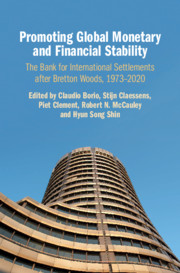 Promoting Global Monetary and Financial Stability
Promoting Global Monetary and Financial Stability How the BIS Helped Reframe Understandings of Financial Stability
Published online by Cambridge University Press: 10 April 2020
This chapter discusses the contribution of BIS research to the shift in the way financial stability issues have been looked at before and after the great financial crisis of 2007–9. It also considers the policy implications for the post-crisis reforms. The 1997–8 Asian crisis was an important turning point, focusing BIS research on the endogenous causes of financial instability and thus on the resilience and the risks of the financial system as a whole. From the late 1990s, the BIS started advocating a macroprudential approach to financial stability, including the adoption of countercyclical macroprudential policies. These ideas, while being shared by some academics and central banks, were largely ignored in policy circles, including in the Basel Committee on Banking Supervision. The chapter argues that the great financial crisis of 2007–9 catapulted these same ideas to the top of the reform agenda. Work done previously by the BIS and others, i.a. on the issue of countercyclical capital buffers, could be leveraged and find its way on the reform agenda pushed by the Financial Stability Board and the G20. The ‘measured contrarianism‘ of the BIS in this area thus added real value.
To save this book to your Kindle, first ensure [email protected] is added to your Approved Personal Document E-mail List under your Personal Document Settings on the Manage Your Content and Devices page of your Amazon account. Then enter the ‘name’ part of your Kindle email address below. Find out more about saving to your Kindle.
Note you can select to save to either the @free.kindle.com or @kindle.com variations. ‘@free.kindle.com’ emails are free but can only be saved to your device when it is connected to wi-fi. ‘@kindle.com’ emails can be delivered even when you are not connected to wi-fi, but note that service fees apply.
Find out more about the Kindle Personal Document Service.
To save content items to your account, please confirm that you agree to abide by our usage policies. If this is the first time you use this feature, you will be asked to authorise Cambridge Core to connect with your account. Find out more about saving content to Dropbox.
To save content items to your account, please confirm that you agree to abide by our usage policies. If this is the first time you use this feature, you will be asked to authorise Cambridge Core to connect with your account. Find out more about saving content to Google Drive.